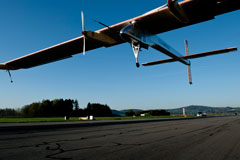May 15 2011
It is up in air and leaving Switzerland for the first time. The Solar Impulse airplane, a solar-powered aircaft that flies without any fuel, set course for its first international destination, landing in the capital of Europe: Brussels. The plane will be displayed in a hangar at Brussels International Airport between May 23 and May 29.
The visit by the Solar Impulse plane coincides with Green Week, Europe’s largest environmental conference. Representatives from politics and business are taking part in the event, which is hosted by the European Commission.
 First Brussels, then Paris: the Solar Impulse plane set course for its first international destination.
First Brussels, then Paris: the Solar Impulse plane set course for its first international destination.
The choice of Brussels as the first non-Swiss destination was not by chance: In 2008, even before Solar Impulse plane existed, the Brussels-based European Commission publicly granted patronage to the Swiss project under its founders, Bertrand Piccard and André Borschberg.
Bayer MaterialScience has been an official partner of the Solar Impulse project, since 2010, contributing technical expertise, high-tech polymer materials and energy-saving lightweight products. Last year, Solar Impulse demonstrated the potential of these new technologies with the first 26-hour endurance flight; comprising both day and night flying, with no fuel other than the power supplied by the sun.
“Solar Impulse has already set records that all involved in the project can be immensely proud of,” said Patrick Thomas, CEO of Bayer MaterialScience.
“This latest flight will see the plane land at Brussels and will be an icon for Europe to see what can be done by sheer determination and the use of the latest technology. We are delighted to see our technologies incorporated in the plane as our mission is to deliver Science For A Better Life.”
Select groups of visitors, including representatives from European institutions, journalists and students will be able to view the plane from May 23 to 29, 2011 at Brussels Airport in Zaventem. Among those on site will be Johannes Seesing, project coordinator at Bayer MaterialScience, who will present the lightweight technologies used in the airplane: “Our focus is on reducing weight as much as possible,” he says.
The first landing outside Switzerland was being painstakingly planned: To operate in an environment as complex as the international air traffic network and the taxiways of Brussels Airport meant anticipating and studying every possible eventuality. Special authorizations had to be obtained for the experimental airplane from the civil aviation authorities in each of the countries it flies over. To ensure its safety and success, a mission as challenging as this requires contributions from a whole team of specialists, including meteorologists from the Royal Belgian Meteorological Institute (IRM), air traffic controllers, engineers and IT specialists.
The next destination for the solar airplane following its stay in Brussels is Paris-Le Bourget Airport in France, where it will be the special guest of the 49th International Paris Air Show from June 20 to 26, 2011.